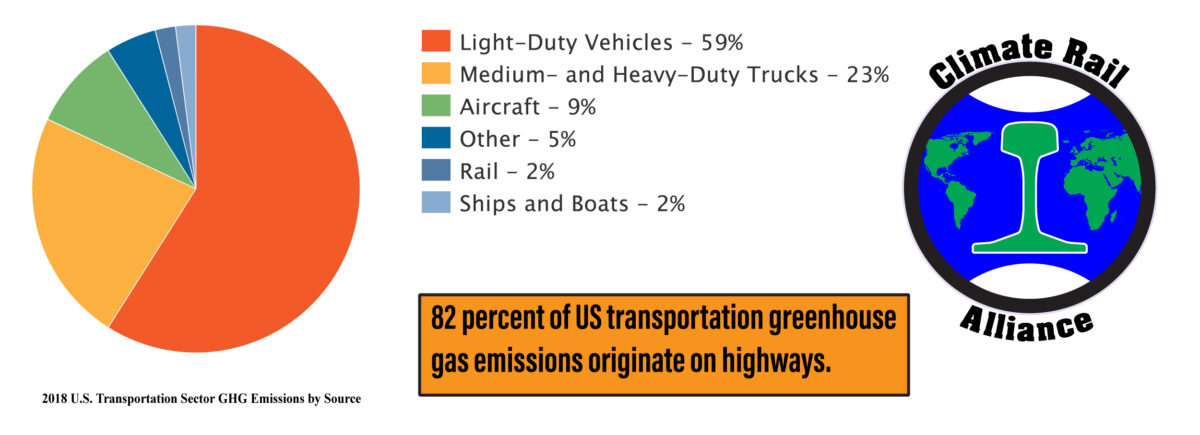Trains are an essential Climate Emergency response.
We must reduce greenhouse gas emissions by about 50 percent by 2030 to prevent irreversible damage to the climate.
Transportation generates 28 percent of greenhouse gas emission in the US. Of that, highways generate 82 percent, air nine percent, rail 2%. Rail transportation uses two thirds less energy than highway and produces two-thirds fewer emissions, even when using diesel locomotives. Shifting as much transportation from highway to rail as possible will have a substantial effect on greenhouse gas emissions.
However…
The rail transportation provided in the US is not an effective climate emergency response. For economic and political reasons, rail transportation in the US is limited. Railroad corporations discourage shipments of less than about 700 miles and shipments of less than a full train load. Trains in the US carry a lot of freight, but an almost inconsequential amount compared to trucks.
Measured by weight, trains carry 9.3 percent of the freight; trucks carry 71.5 percent.
(The Climate Emergency: Trains-An Effective Response Page 42)
Measured by value, trains carry 1.4 percent of the shipments; trucks carry 73 percent.
This situation is unacceptable, particularly in regard to the climate emergency.
Why is US rail service so ineffective?
Railroad corporations are common carriers. They are required by law (49 USC 11101) to provide transportation to all parties upon reasonable request. They are also corporations that are required by law to generate the greatest possible profit.
Rail freight traffic charges are typically based upon the weight of the shipment and the distance traveled. The heaviest shipments traveling the longest distance are the most profitable business. Everything else is discouraged. That is the reason for the low percentage of rail freight compared to truck. That is also a contributing reason for the poor passenger rail service in the US.
Railroad corporations discourage the business they don’t want through high rates, poor service, or both. The government does not consider this approach to be in violation of their common carrier obligations because there is competition: trucks. Any customer that does not like the railroad corporation’s rates or service is welcome to use trucks…and they do.
The railroad corporations own almost all of the US rail infrastructure (Amtrak, which acts like the railroad corporations in many ways, owns some segments). Not only do they decide what traffic they will accept, they prevent anyone else from taking that traffic on their tracks. They own the tracks and are free to dictate who gets to use them. In rare instances, the government has required one railroad corporation to allow trains of another, but generally, the use of each railroad corporation’s track is limited to its own trains.
The EU found a solution
In most other countries, the government owns the rail infrastructure. Those countries decided long ago that rail transportation was too valuable to be trusted to for-profit corporations. The governments of Europe also discovered that rail infrastructure was too valuable to be trusted to a monopoly, even if the monopoly was the government. The EU developed a solution to that problem – open access.
Effectively, the European rail network has become a rail toll road. Access is open to any entity that wants to provide transportation. For example, there are 250 train operating companies providing service on the German rail network. The track owner is required to provide non discriminatory access to the network. This arrangement allows all desirable rail transportation to be available.
The regulation does not change the ownership of the infrastructure, only the financial and governing arrangement. The infrastructure must be a separate subsidiary of the corporation. For example, Deutsche Bahn, the German National railroad company owns the infrastructure, but infrastructure is only one of the nine separate companies owned by the parent company.
Each infrastructure company has a published table of standard fees. Each train operating company pays for access to the system based on the table, which considers factors such as desired travel time, train size, and time of day.
How does that work here?
Other countries chose to nationalize their railroad infrastructure long ago. The US political and economic arrangement makes nationalization impractical. Property owners must be fairly compensated when the government takes their property. The US rail network involves a huge amount of property. The court cases for the lawsuits over fair compensation could last decades (and be very expensive).
The practical alternative is regulation similar to that of the EU. Require infrastructure and transportation to be economically and operationally separate. Require the infrastructure owners to provide non discriminatory access to all train operators, charging a standard scale fee for access.
Under this arrangement, the rail network is available to an aggressive effort to shift highway transportation to rail, with new train operating companies providing service that the big railroad corporations do not want to provide.
Effective use of the rail network is an essential element of rail as a climate emergency response.
Learn more in The Climate Emergency: Trains-An Effective Response.
TAW
